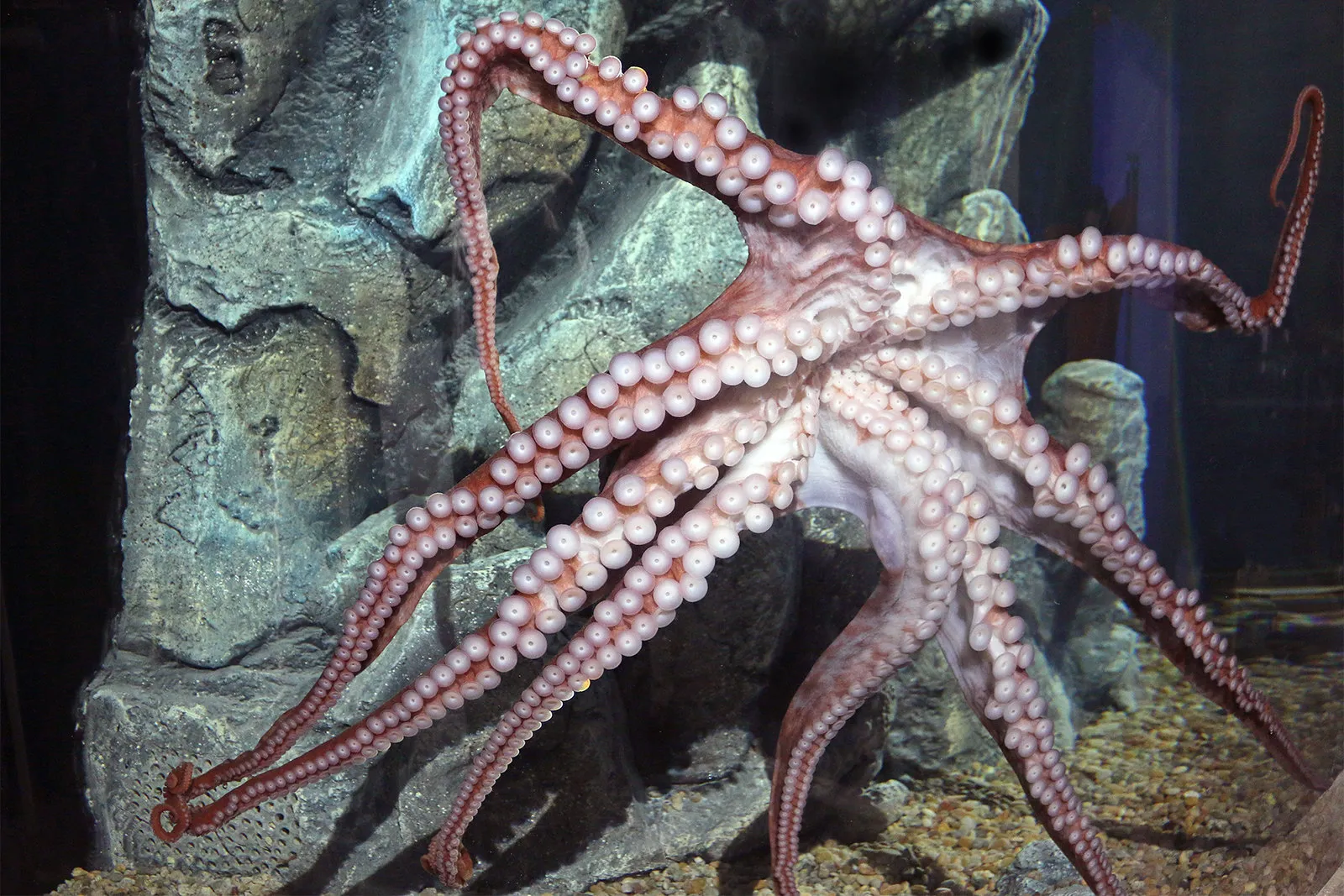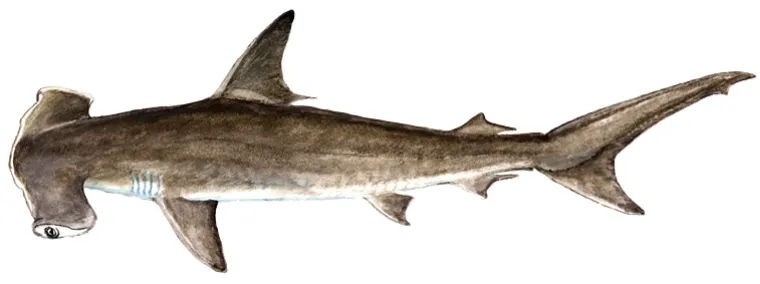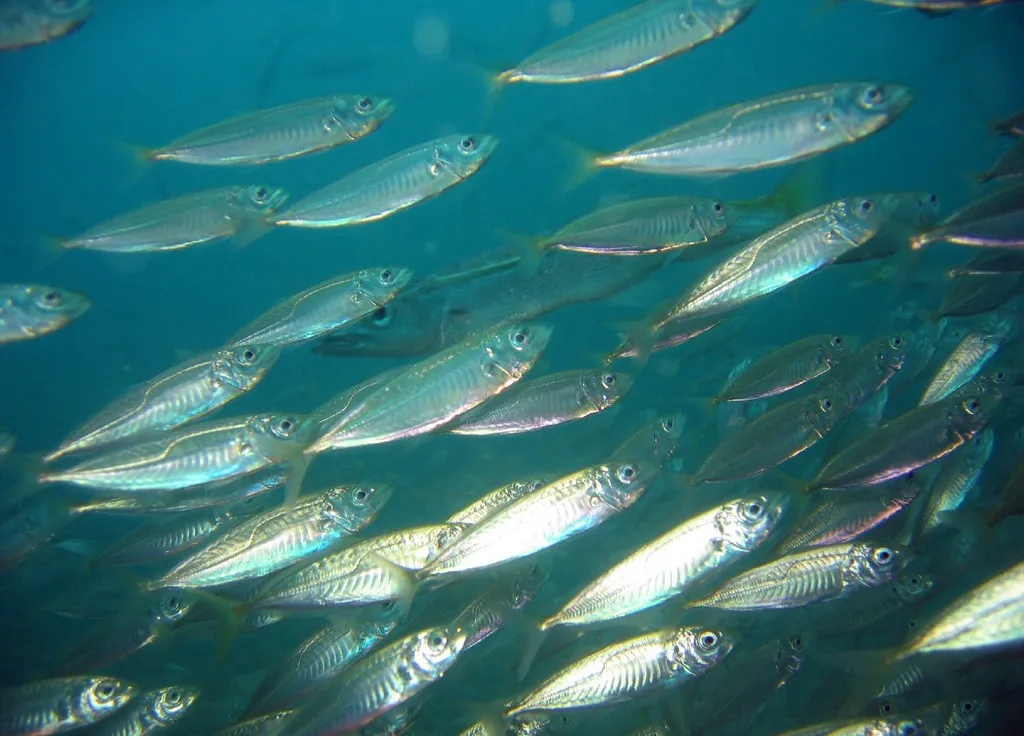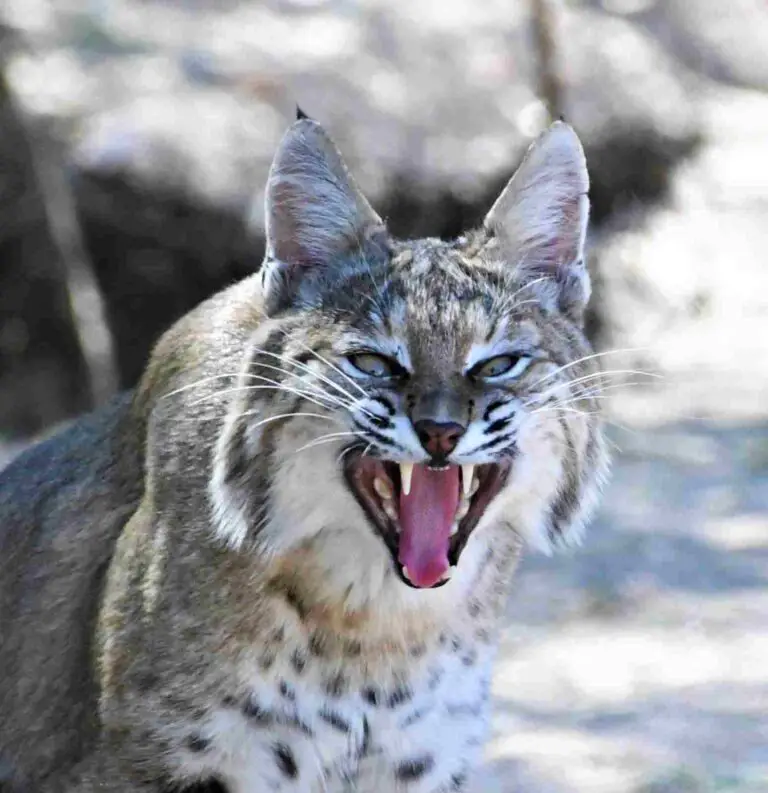11+ Secondary Consumers in the Ocean and Their Characteristics
Secondary consumers in the ocean occupy an intermediate position in marine food webs, preying on primary consumers such as zooplankton, small fish, and crustaceans. They play crucial roles in regulating prey populations, facilitating energy transfer, and maintaining ecosystem balance. Examples include predatory fish like sharks and tuna, marine mammals like dolphins, and cephalopods such as squid. These secondary consumers contribute to the complexity and resilience of marine ecosystems through their predatory behavior and ecological interactions.
Predatory Invertebrates/Primitive Secondary Consumers in the Ocean

Predatory invertebrates play a crucial role as primitive secondary consumers in marine ecosystems. These organisms typically prey on smaller animals, contributing to the regulation of population sizes and maintaining the balance within the food web. Examples of predatory invertebrates include:
-
Giant Pacific Octopus: With its impressive hunting capabilities and flexible tentacles, the giant Pacific octopus preys on crustaceans, mollusks, and even small fish, occupying a significant position in the ocean’s secondary consumer hierarchy.
-
Lion’s Mane Jellyfish: While jellyfish are often considered primary consumers, some species, like the lion’s mane jellyfish, exhibit predatory behavior, consuming smaller planktonic organisms and fish larvae, thus functioning as primitive secondary consumers in certain marine ecosystems.
-
Sea Stars (Starfish): These voracious predators feed on a variety of organisms, including mollusks, small fish, and even other echinoderms. Sea stars exert significant control over the populations of their prey species, making them important secondary consumers in the oceanic food web.
-
Giant Squid: Known for their elusive nature and formidable size, giant squids are apex predators in many marine environments. They prey on fish, smaller cephalopods, and even marine mammals, occupying a prominent position as secondary consumers in the oceanic ecosystem.
-
Crabs: Various species of crabs serve as secondary consumers in the ocean, preying on a diverse range of organisms such as small fish, crustaceans, mollusks, and even other crabs. Their predatory behavior contributes to the intricate dynamics of marine food chains.
Small Sea Birds/Simple Secondary Consumers in the Ocean
Small sea birds play a significant role as simple secondary consumers in the marine ecosystem, primarily feeding on smaller fish, crustaceans, and other marine organisms. These birds contribute to the transfer of energy within the oceanic food web and help regulate the populations of their prey. Examples of small sea birds acting as secondary consumers in the Pacific Ocean include:
-
Seabirds: Various species of seabirds, such as terns, gulls, and shearwaters, hunt for fish near the ocean’s surface or dive underwater to catch prey. They serve as important secondary consumers by feeding on small fish, squid, and crustaceans, thus occupying a vital niche in the Pacific Ocean’s ecosystem.
-
Penguins: While primarily associated with colder regions like Antarctica, several species of penguins inhabit the Pacific Ocean’s coastal areas. Penguins feed predominantly on fish, krill, and squid, making them simple secondary consumers in the oceanic food chain.
-
Frigatebirds: These aerial predators are adept at catching flying fish and other small prey items near the ocean’s surface. Frigatebirds also scavenge for food, feeding on fish and squid caught by other marine creatures. Their feeding habits place them within the category of secondary consumers in the Pacific Ocean’s ecosystem.
Small Shark Species/Mesopredator Secondary Consumers in the Ocean

Small shark species play a crucial role as mesopredator secondary consumers in marine ecosystems, occupying a niche between larger predators and their prey. These sharks typically feed on smaller fish, cephalopods, and crustaceans, contributing to the regulation of prey populations and maintaining ecosystem balance. Examples of small shark species acting as secondary consumers in the ocean include:
-
Blue Shark (Prionace glauca): Blue sharks are widely distributed across the world’s oceans, including the Pacific Ocean. As mesopredators, they primarily feed on small fish, squid, and pelagic crustaceans, serving as important secondary consumers in the Pacific Ocean’s food web.
-
Blacktip Reef Shark (Carcharhinus melanopterus): Found in shallow coastal waters of the Pacific Ocean, blacktip reef sharks prey on a variety of small fish, crustaceans, and cephalopods. These sharks play a significant role as mesopredator secondary consumers, contributing to the biodiversity and ecological stability of coral reef ecosystems.
-
Smooth Hammerhead Shark (Sphyrna zygaena): Although larger hammerhead species exist, smooth hammerhead sharks are smaller mesopredators commonly found in the Pacific Ocean. They feed on a diverse range of prey, including smaller fish, squid, and crustaceans, playing a vital role as secondary consumers in oceanic food webs.
These small shark species help regulate the populations of their prey, prevent overgrazing of marine habitats, and contribute to the overall health and functioning of marine ecosystems in the Pacific Ocean and beyond.
Zooplankton-Consuming Vertebrates/Mesopredator Secondary Consumers in the Ocean

Zooplankton-consuming vertebrates are essential mesopredator secondary consumers in the oceanic ecosystem, playing a critical role in controlling zooplankton populations and facilitating energy transfer through marine food webs. These vertebrates primarily feed on zooplankton, small fish, and other planktonic organisms, contributing to the intricate dynamics of oceanic ecosystems. Examples of zooplankton-consuming vertebrates acting as secondary consumers in the ocean include:
-
Mackerel (Scombridae family): Mackerel are pelagic fish species found in the Pacific Ocean, known for their voracious appetite for zooplankton and small fish. As mesopredators, they help regulate zooplankton populations and serve as important secondary consumers in the oceanic food web.
-
Anchovies (Engraulidae family): Anchovies are small, schooling fish found in coastal regions of the Pacific Ocean. They primarily feed on zooplankton, including copepods and krill, making them significant secondary consumers in marine ecosystems. Anchovies play a crucial role in transferring energy from lower trophic levels to higher trophic levels through predation.
-
Sardines (Clupeidae family): Sardines are another group of small, pelagic fish species commonly found in the Pacific Ocean. They feed on a variety of zooplankton, including small crustaceans and fish larvae, contributing to the regulation of zooplankton populations and functioning as mesopredator secondary consumers in marine food webs.
These zooplankton-consuming vertebrates help maintain the balance of marine ecosystems by controlling the abundance of zooplankton and facilitating energy flow through the food chain. Their predatory behavior is essential for the sustainability and resilience of oceanic ecosystems in the Pacific Ocean and beyond.
General Characteristics of Ocean Secondary Consumers
Ocean secondary consumers exhibit several key characteristics that define their role within marine ecosystems:
-
Predatory Behavior: Secondary consumers in the ocean are predators that actively hunt and consume other organisms. They play a crucial role in controlling the populations of primary consumers and regulating the overall structure of marine food webs.
-
Mesopredator Status: Many ocean secondary consumers are considered mesopredators, occupying a middle position in the food chain between primary consumers and apex predators. They may prey on smaller organisms while being preyed upon by larger predators.
-
Diverse Diet: Ocean secondary consumers have a diverse diet, feeding on a variety of prey including smaller fish, crustaceans, cephalopods, and zooplankton. This dietary diversity allows them to adapt to changes in prey availability and environmental conditions.
-
Ecological Importance: Secondary consumers play a crucial role in energy transfer within marine ecosystems, channeling energy from primary producers to higher trophic levels. They help maintain ecosystem balance and stability by controlling prey populations and preventing overgrazing of resources.
-
Population Regulation: By preying on primary consumers, secondary consumers help regulate the abundance of prey species, preventing population outbreaks that could disrupt ecosystem dynamics. They also face predation pressure from larger predators, which influences their own population dynamics.
Overall, ocean secondary consumers play a vital role in shaping marine ecosystems, contributing to biodiversity, nutrient cycling, and ecosystem resilience in the face of environmental changes.
Five Secondary Consumers in the Ocean
-
Barracuda: These sleek predators are found in tropical and subtropical waters worldwide. They primarily feed on smaller fish, including reef fish and pelagic species, making them important secondary consumers in various marine ecosystems.
-
Moray Eel: Moray eels are predatory fish commonly found in coral reefs and rocky crevices. They prey on crustaceans, small fish, and occasionally other eels, occupying a significant position as secondary consumers in reef ecosystems.
-
Dolphin: Dolphins are highly intelligent marine mammals that hunt and feed on a variety of prey, including fish, squid, and crustaceans. They play a vital role as secondary consumers in oceanic food webs, particularly in open ocean environments.
-
Yellowfin Tuna: Yellowfin tuna are large, pelagic fish species found in tropical and subtropical waters worldwide. They feed on smaller fish, squid, and crustaceans, serving as important secondary consumers in the pelagic zone of the ocean.
-
Leopard Seal: Leopard seals are apex predators in Antarctic and sub-Antarctic regions, feeding on a variety of prey including fish, squid, and other seals. They occupy a top position as secondary consumers in polar marine ecosystems.
These five examples demonstrate the diversity of secondary consumers in the ocean, ranging from fish to marine mammals, each playing a unique role in maintaining the balance and functioning of marine ecosystems.
Three Secondary Consumers in the Pacific Ocean
-
California Sea Lion: Found along the western coast of North America, California sea lions are highly adaptable predators in the Pacific Ocean. They feed on a variety of prey including fish, squid, and crustaceans, making them significant secondary consumers in coastal ecosystems of the Pacific.
-
Pacific Bluefin Tuna: This large, migratory fish species is native to the Pacific Ocean and is highly prized for its meat. Pacific bluefin tuna feed on smaller fish, squid, and crustaceans, occupying an important position as secondary consumers in pelagic regions of the Pacific.
-
Galapagos Shark: Endemic to the Galapagos Islands and surrounding waters, the Galapagos shark is a top predator in its ecosystem. Feeding on a variety of prey including fish, squid, and rays, Galapagos sharks serve as important secondary consumers in the Pacific Ocean’s marine food webs.
These three examples illustrate the diversity of secondary consumers in the Pacific Ocean, highlighting the range of species and their roles in maintaining the health and balance of marine ecosystems across the region.
Water Animals as Secondary Consumers
Water animals encompass a broad range of species that serve as secondary consumers in aquatic ecosystems, including oceans. Secondary consumers in water environments play pivotal roles in regulating populations of primary consumers and shaping the dynamics of food webs. Some common types of water animals acting as secondary consumers include:
-
Fish: Various species of fish, ranging from small to large, occupy the secondary consumer trophic level in water ecosystems. Examples include salmon, trout, bass, and tuna, which prey on smaller fish, crustaceans, and other organisms.
-
Marine Mammals: Marine mammals such as dolphins, seals, sea lions, and otters are prominent secondary consumers in marine environments. They hunt and feed on a variety of prey, including fish, squid, crustaceans, and sometimes other marine mammals.
-
Sharks: Sharks encompass a diverse group of apex predators and mesopredators in marine ecosystems. While some larger shark species occupy the top of the food chain, smaller shark species such as reef sharks and blacktip sharks serve as secondary consumers, feeding on smaller fish and marine invertebrates.
-
Cephalopods: Squid, octopus, and cuttlefish are predatory cephalopods that act as secondary consumers in marine food webs. They prey on smaller fish, crustaceans, and mollusks, exerting control over prey populations and contributing to ecosystem dynamics.
-
Crustaceans: Certain crustaceans, such as crabs and lobsters, function as secondary consumers in aquatic ecosystems. They feed on a variety of prey items, including smaller crustaceans, mollusks, and detritus, playing vital roles in nutrient cycling and ecosystem balance.
These water animals demonstrate the diverse array of species that occupy the secondary consumer trophic level in aquatic environments, highlighting their importance in maintaining the health and functioning of marine ecosystems worldwide.
Types of Secondary Consumers in the Ocean
Secondary consumers in the ocean encompass a wide range of organisms with diverse feeding habits and ecological roles. Here are some common types of secondary consumers in marine ecosystems:
-
Predatory Fish: Numerous species of predatory fish, including groupers, barracudas, snappers, and jacks, serve as secondary consumers in oceanic food webs. They hunt smaller fish, crustaceans, and cephalopods, regulating prey populations and contributing to ecosystem stability.
-
Marine Mammals: Dolphins, seals, sea lions, and whales are prominent secondary consumers in the ocean. These marine mammals feed on various prey items such as fish, squid, and crustaceans, playing critical roles in energy transfer and nutrient cycling.
-
Sharks: Sharks are apex predators and mesopredators that occupy different trophic levels in marine ecosystems. While large sharks like great whites and tiger sharks are apex predators, smaller species like reef sharks and dogfish sharks act as secondary consumers, preying on smaller fish and invertebrates.
-
Cephalopods: Squid, octopus, and cuttlefish are predatory cephalopods that function as secondary consumers in oceanic food chains. They feed on smaller fish, crustaceans, and mollusks, exerting control over prey populations and serving as prey for larger predators.
-
Crustaceans: Crabs, lobsters, and shrimp are examples of crustaceans that serve as secondary consumers in marine ecosystems. They feed on a variety of prey items, including smaller crustaceans, mollusks, and detritus, contributing to nutrient cycling and ecosystem functioning.
These types of secondary consumers illustrate the diversity of organisms occupying this trophic level in the ocean, each playing unique roles in maintaining the balance and health of marine ecosystems.
Food Chain Position and Role of Secondary Consumers in the Ocean
Secondary consumers in the ocean occupy a crucial position in marine food chains and play several vital roles in ecosystem dynamics:
-
Energy Transfer: Secondary consumers play a significant role in transferring energy through marine food webs. They acquire energy by consuming primary consumers (herbivores) or other secondary consumers, thereby channeling energy from lower to higher trophic levels.
-
Population Regulation: By preying on primary consumers, secondary consumers help regulate the abundance of prey species. This prevents overgrazing of primary producers and maintains a balance within the ecosystem.
-
Control of Prey Populations: Secondary consumers exert top-down control on prey populations, influencing the abundance and distribution of various species within the ecosystem. This control helps prevent the dominance of certain species and promotes biodiversity.
-
Disease Control: Some secondary consumers, particularly certain species of fish, help control the spread of diseases among prey populations by selectively targeting diseased individuals. This contributes to the overall health of the ecosystem.
-
Ecosystem Stability: Secondary consumers contribute to the stability of marine ecosystems by maintaining the balance between predator and prey populations. Their presence helps prevent population outbreaks or crashes that could disrupt the functioning of the ecosystem.
Overall, secondary consumers play a critical role in shaping marine ecosystems, regulating energy flow, controlling populations, and maintaining biodiversity. Their interactions with other organisms within the food web are essential for the health and resilience of oceanic ecosystems.
Examples of Consumers in the Ocean
Consumers in the ocean encompass a diverse array of organisms that play essential roles in marine ecosystems. Here are some examples:
-
Primary Consumers (Herbivores):
-
Zooplankton: Tiny organisms such as copepods and krill that feed on phytoplankton.
-
Herbivorous Fish: Species like parrotfish and surgeonfish that graze on algae and seagrasses.
-
Sea Urchins: Grazers that feed on algae and kelp.
-
-
Secondary Consumers (Predators):
-
Sharks: Apex predators that hunt a variety of prey, including fish, seals, and other marine mammals.
-
Dolphins: Highly intelligent predators that feed on fish, squid, and crustaceans.
-
Tuna: Fast-swimming predators that prey on smaller fish and squid.
-
-
Tertiary Consumers (Top Predators):
-
Killer Whales: Apex predators that feed on a wide range of prey, including fish, seals, and even other whales.
-
Large Sharks: Predators like great white sharks and tiger sharks that occupy the top of the food chain.
-
Polar Bears: Marine mammals that hunt seals and other prey in Arctic and sub-Arctic regions.
-
-
Scavengers and Detritivores:
-
Crabs: Bottom-dwelling scavengers that feed on dead organisms and detritus.
-
Vultures: Birds that scavenge on carcasses floating at the ocean’s surface.
-
Hagfish: Primitive scavengers that feed on decaying organic matter on the ocean floor.
-
-
Filter Feeders:
-
Baleen Whales: Filter feeders that consume vast quantities of zooplankton by filtering them through baleen plates.
-
Manta Rays: Filter feeders that consume plankton and small fish by swimming with their mouths open.
-
Clams: Bivalves that filter plankton and organic particles from the water column.
-
*Key Takeaways
- Consumers in the ocean are diverse, ranging from primary herbivores to top predators.
- Primary consumers, such as zooplankton and herbivorous fish, form the base of marine food webs by feeding on phytoplankton and algae.
- Secondary consumers, including sharks, dolphins, and tuna, prey on primary consumers and play crucial roles in regulating prey populations.
- Tertiary consumers, like killer whales and large sharks, occupy the top of the marine food chain and exert significant control over ecosystem dynamics.
- Scavengers and detritivores, such as crabs and hagfish, contribute to nutrient recycling by feeding on dead organisms and organic matter.
- Filter feeders, like baleen whales and manta rays, consume plankton and organic particles, playing essential roles in filtering and purifying the water column.
- The interactions among these different types of consumers help maintain the balance and health of marine ecosystems.
| Consumer Type | Examples |
Role in Ecosystem
|
| Primary Consumers | Zooplankton, Herbivorous Fish, Sea Urchins |
Form the base of marine food webs by feeding on phytoplankton and algae.
|
| Secondary Consumers | Sharks, Dolphins, Tuna |
Prey on primary consumers and regulate prey populations; contribute to energy transfer.
|
| Tertiary Consumers | Killer Whales, Large Sharks |
Occupy the top of the food chain and exert significant control over ecosystem dynamics.
|
| Scavengers/Detritivores | Crabs, Hagfish, Vultures |
Contribute to nutrient recycling by feeding on dead organisms and organic matter.
|
| Filter Feeders | Baleen Whales, Manta Rays, Clams |
Consume plankton and organic particles, contributing to water column filtration.
|
FAQs about Ocean Consumers
- Q: What are primary consumers in the ocean?
- A: Primary consumers in the ocean are organisms that feed directly on primary producers, such as phytoplankton and algae. Examples include zooplankton, herbivorous fish, and sea urchins.
- Q: How do secondary consumers contribute to marine ecosystems?
- A: Secondary consumers in the ocean prey on primary consumers, regulating prey populations and contributing to energy transfer through marine food webs. They play important roles in maintaining ecosystem balance and stability.
- Q: What are apex predators in marine ecosystems?
- A: Apex predators are top predators in marine food chains that have no natural predators of their own. Examples include killer whales, large sharks, and polar bears.
- Q: What role do scavengers and detritivores play in the ocean?
- A: Scavengers and detritivores in the ocean play crucial roles in nutrient cycling by feeding on dead organisms and organic matter. They help recycle nutrients back into the ecosystem.
- Q: How do filter feeders contribute to water quality in the ocean?
- A: Filter feeders, such as baleen whales and clams, consume plankton and organic particles, helping to filter and purify the water column. They play important roles in maintaining water quality and clarity.
- Q: What are some examples of mesopredators in marine ecosystems?
- A: Mesopredators are intermediate-level predators in marine food webs. Examples include smaller shark species, medium-sized fish like barracuda, and certain species of marine mammals like sea lions.
- Q: How do consumers in the ocean adapt to changes in their environment?
- A: Consumers in the ocean exhibit various adaptations to cope with environmental changes, including changes in prey availability, water temperature, and habitat conditions. These adaptations may include shifts in diet, changes in behavior, or migration to different areas.


